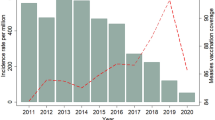Abstract
The present study was conducted in Union Territory of Chandigarh to find out the utilization pattern of manpower engaged in the implementation of Pulse Polio Campaign (PPI) on 7th December, 1997 with the objective to achieve a coverage close to 100% and thereby, eradicating poliomyelitis. Over 100,000 under-five children were expected to participate on PPI day. Out of 240 polio centres established in the Union Territory, 16 were selected by stratified random sampling covering 14,858 children. The observing teams recorded the information about the children and presence of staff members throughout the day between 8.00 a.m. and 5.00 p.m. It was observed that nearly half of the children received the polio drops within the first three hours while only a little over 5% visited polio centres in the last two hours. The average number of manpower varied between 5 and 6 throughout the day (more than the recommended four). The staff posted at urban, rural and slum centres did not visit the houses except for the few volunteers in slums.
Unimmunized children should be identified by the staff in last two hours when the load at polio centres is extremely low. Adequate utilization of the full potential of the manpower will help in enhancing the PPI coverage close to 100%.
Similar content being viewed by others
References
MCH division, Department of Family Welfare, Ministry of Health and Family Welfare Surveillance of Acute Flaccid Paralysis Field. 1997; 4.
World Health Organization Expanded Programme of Immunization poliomyelitis in 1988,1989, and 1990.Weekly Epidemic Rec 1992; 67:113–8.
Idris MZ, Mathus A, Sharma P, Chaturve-di VC, Sharma NL. Oral polio vaccination and factors affecting its efficacy.Indian J Med Res 1980; 71: 671–8
Swami HM, Bhatia V, Bhatia SPS, Singh K, Kaur M, Kaur A. Existing MCH services in rural areas of Chandigarh.Indian J Community Medicine 1997; Vol 12: 110–113.
Ministry of Health and Family Welfare (GOI). Evaluation of pulse polio immunization.National Immunization Day 1997; 12.
MCH division, Department of Family Welfare, Ministry of Health and Family Welfare. Pulse Polio Immunization in India.Operational Guide 1996; 41.
MCH division, Department of Family Welfare, Ministry of Health and Family Welfare. Pulse Polio Immunization in India.Operational Guide 1995; 27.
Author information
Authors and Affiliations
Rights and permissions
About this article
Cite this article
Bhatia, V., Swami, H.M., Bhan, V.K. et al. Manpower utilization in pulse polio immunization. Indian J Pediatr 66, 859–862 (1999). https://doi.org/10.1007/BF02723854
Issue Date:
DOI: https://doi.org/10.1007/BF02723854




